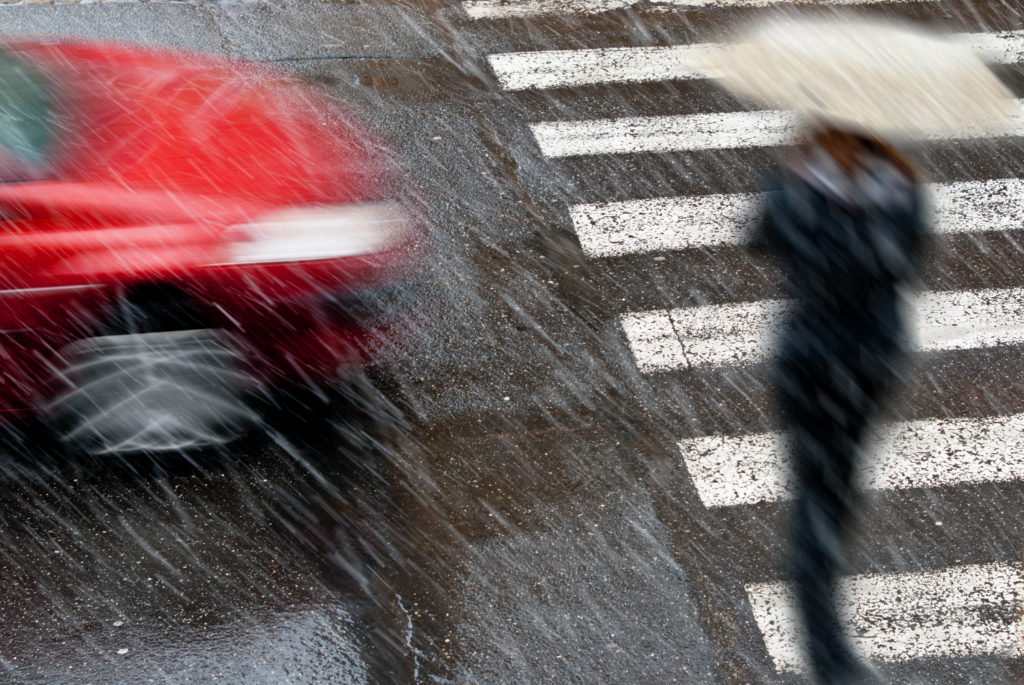
Collisions between vehicles and pedestrians almost never end well for the latter, who, unshielded by a vehicle and lacking the protections of seatbelts and airbags, are much more likely to sustain devastating injuries. The type and severity of pedestrian accident injuries is dictated by a wide range of factors, including the size of the vehicle, the speed at which the car was traveling, and where the pedestrian was struck. Read on to learn more about these factors and how their application could affect your own accident-related injuries.
Number of Impacts
When a pedestrian is struck by the front end of a vehicle, the height of the impact in comparison to the location of the pedestrian’s center of gravity will play a critical role in the type and severity of the injuries sustained. Most vehicle-pedestrian collisions, for instance, occur when the pedestrian’s center of gravity is higher than the vehicle’s bumper. This means that the front bumper usually strikes the victim’s lower leg region first, with the legs accelerating in the direction that the vehicle is traveling, immediately followed by contact between the thigh area and the hood. These initial impacts cause the upper body to rotate and result in another impact between the head or shoulders and the hood or windshield region of the vehicle.
Speed of Impact
Pedestrian accidents can look a bit different when the collision occurs at higher speeds, where, for instance, the increased momentum can cause the legs to rotate above the head before they fall back to the hood. In other cases, a pedestrian could actually somersault onto the roof or windshield after sustaining the head impact, while further increases in impact speed can lead to a pedestrian passing completely over the vehicle, which in turn, can result in subsequent impacts not only with the ground, but also other roadway objects as the pedestrian comes to rest.
Severity of Injuries
Besides the angle of impact, the pedestrian’s center of gravity, and vehicle speed, the severity of a pedestrian injury will depend on a variety of other factors, including:
- The part of the body that first came into contact with the vehicle;
- The part of the vehicle struck first by the victim; and
- The vehicle’s design.
These elements all make it much more likely that a pedestrian will sustain certain types of injuries, including:
- Musculoskeletal injuries;
- Chest and abdominal injuries;
- Injuries to the legs and pelvis;
- Tibial plateau fractures and ligamentous injuries to the knee; and
- Traumatic brain injuries.
If you or a loved one sustained any of these kinds of injuries in a pedestrian accident, you could be entitled to compensation for your losses. Call our legal team today to learn more.
Risk Factors for Pedestrian Collisions
Although anyone can be injured in a pedestrian accident, there are certain risk factors that make it more likely that certain individuals will be involved in these kinds of crashes. Two of the most important factors are when and where the collisions occur. Most collisions between vehicles and pedestrians, for instance, occur between the hours of 6:00 p.m. and 12:00 a.m. Impaired vision, combined with increased pedestrian traffic are thought to account for the higher incidence of pedestrian accidents in the nighttime hours. More than two-thirds of pedestrian fatalities occur in urban areas, which makes sense, as this is where pedestrians are more likely to be walking. As many as three-fourths of pedestrian fatalities occur in non-intersections. Failing to comply with speed limits, poor city planning, and distracted driving all contribute to these alarming numbers.
Rural areas also pose their own risks to pedestrians. For instance, while the overall number of collisions is fewer than in urban areas, pedestrian injuries that do occur are almost always more severe and more likely to be fatal. This is thought to be due to the higher vehicle speeds in rural areas, a lack of walkways and sidewalks, and a longer distance to hospitals.
Miami Pedestrian Accident Lawyer
Dolan Dobrinsky Rosenblum Bluestein is not a high-volume law practice. This is intentional, as we pride ourselves on our ability to devote all of our attention, experience, and resources to each of our cases. If you entrust your case to us, you can rest assured that we will give it all of the time and attention that it deserves. From our office in Miami, we serve accident victims throughout south and central Florida. To set up a free consultation with a member of our legal team, feel free to call our office at 305-371-2692 today.